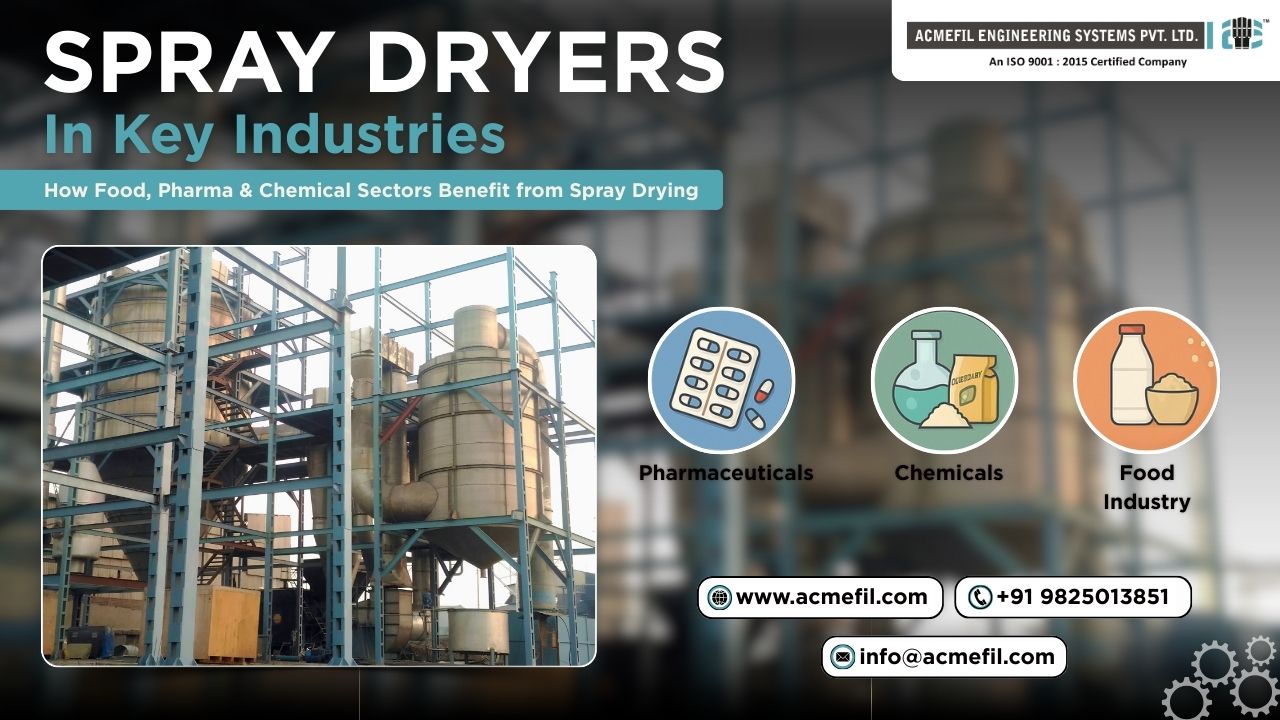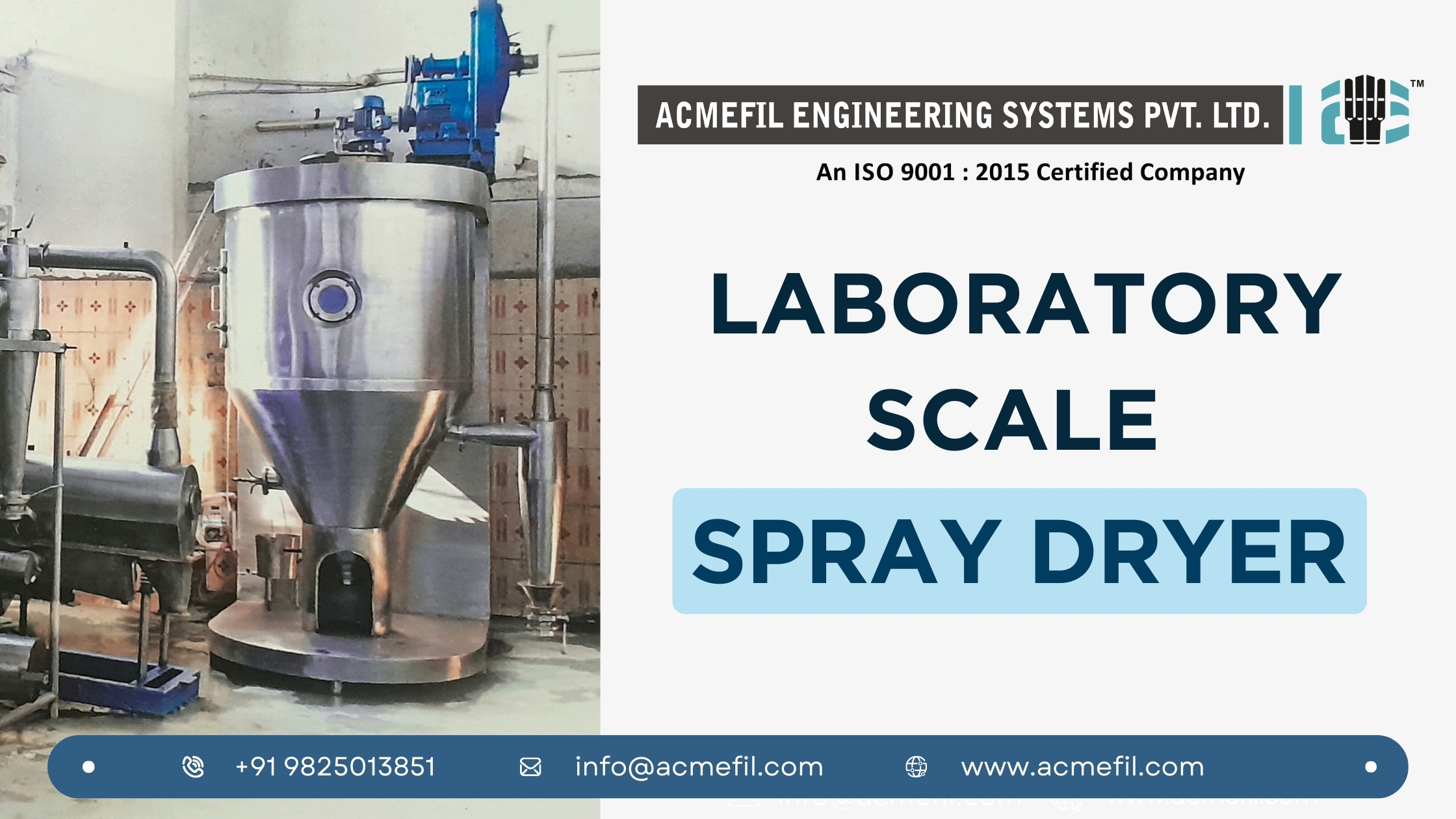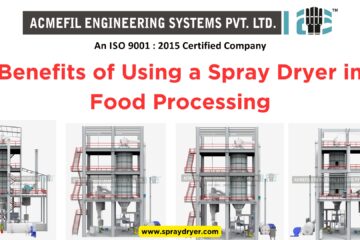Have you ever wondered how powdered milk maintains its quality for months? Or how pharmaceutical companies produce perfectly uniform drug particles? The answer lies in an ingenious technology called spray drying. This transformative process has revolutionized multiple industries by enabling the conversion of liquid products into dry powder form with precise control over particle characteristics.
In this comprehensive guide, we’ll explore the diverse applications of spray dryers across the food, pharmaceutical, and chemical industries. You’ll discover how this versatile technology solves critical manufacturing challenges while delivering remarkable benefits in product quality, shelf life, and operational efficiency.
Table of Contents
What Are Spray Dryers and How Do They Work?
Spray drying is a method of producing dry powder from a liquid or slurry by rapidly drying with hot gas. This single-step continuous process transforms liquids into dry particles in seconds, making it one of the most efficient drying technologies available today.
The Spray Drying Process Explained
The spray drying process follows these key steps:
- Atomization: The feed liquid is dispersed into fine droplets using specialized nozzles or rotary atomizers.
- Droplet-air contact: These tiny droplets are exposed to hot air in a drying chamber.
- Moisture evaporation: The large surface area of the droplets enables rapid moisture removal.
- Particle formation: As moisture evaporates, solid particles form and fall to the bottom of the chamber.
- Powder collection: The final powder product is collected through cyclones or bag filters.
This elegant process preserves many critical properties of the original material while transforming it into a convenient powder form. The applications of spray dryers continue to expand as industries discover new ways to leverage this technology.
Applications of Spray Dryers in the Food Industry
The food industry represents one of the largest sectors utilizing spray drying technology. From everyday staples to specialized nutritional products, spray dryers play a crucial role in food manufacturing.
Dairy Products
Dairy processing stands as perhaps the most prominent application of spray dryers in food manufacturing:
- Milk powder: Converts fresh milk into a shelf-stable powder with 18-24 month shelf life
- Whey protein: Creates concentrated protein supplements for sports nutrition
- Infant formula: Produces precisely formulated nutritional products with consistent composition
- Cheese powder: Transforms cheese into convenient flavoring ingredients
Spray drying enables dairy manufacturers to extend product shelf life dramatically while reducing transportation costs by removing water weight. The resulting powders maintain their nutritional value and can be easily reconstituted when needed.
Flavors and Seasonings
Food flavoring represents another critical application of spray dryers:
- Flavor encapsulation: Protects volatile flavor compounds from degradation
- Seasoning blends: Creates uniform powder mixtures for convenience foods
- Natural extracts: Preserves plant-derived flavors in stable powder form
- Food colorants: Converts liquid colorants into easily dispersible powders
By encapsulating flavor compounds within carrier materials, spray drying helps preserve taste integrity while extending shelf life. This technology enables food manufacturers to create consistent flavor profiles across production batches.
Fruits and Vegetables
Converting fruits and vegetables into powder form offers significant advantages:
- Fruit juice powders: Creates instant drink mixes and flavor ingredients
- Vegetable extracts: Preserves nutritional compounds in shelf-stable form
- Tomato powder: Offers concentrated tomato flavor for soups and sauces
- Functional food ingredients: Delivers antioxidants and phytochemicals in convenient form
These powdered products maintain much of their nutritional value while enabling year-round availability of seasonal produce. Food manufacturers can incorporate these ingredients into countless products without the moisture-related challenges of fresh produce.
Coffee and Tea
The beverage industry extensively utilizes spray drying for:
- Instant coffee: Transforms brewed coffee into convenient soluble powder
- Tea extracts: Creates instant tea powders and flavoring ingredients
- Powdered drink mixes: Produces complete beverage formulations that dissolve quickly
The coffee industry in particular has perfected spray drying techniques to preserve aromatic compounds that contribute to flavor quality in instant products.
Applications of Spray Dryers in the Pharmaceutical Industry
Pharmaceutical manufacturers rely on spray drying for creating specialized drug formulations with enhanced properties. This technology offers unparalleled control over particle characteristics, making it invaluable for modern drug delivery systems.
Drug Formulation and Delivery Systems
Spray drying enables pharmaceutical companies to create advanced drug products:
- Inhalable powders: Produces precise particle sizes for pulmonary drug delivery
- Solid dispersions: Improves dissolution rates of poorly water-soluble drugs
- Microencapsulation: Creates controlled-release formulations with specific release profiles
- Protein stabilization: Preserves biological activity of sensitive therapeutic proteins
These sophisticated applications of spray dryers help overcome formulation challenges that would otherwise limit drug efficacy. For example, by creating amorphous solid dispersions, manufacturers can significantly enhance the bioavailability of drugs that would normally have poor absorption.
Vaccine Production
Vaccine development represents a critical application of spray dryers:
- Thermostable vaccines: Creates heat-resistant formulations that reduce cold chain requirements
- Adjuvant delivery: Combines immunostimulants with antigens in uniform particles
- Mucosal vaccines: Develops powder formulations for nasal or oral administration
- Long-term stability: Extends shelf life of vaccine components
The COVID-19 pandemic highlighted the importance of robust vaccine supply chains. Spray dried vaccine formulations offer advantages in stability and distribution, potentially expanding global vaccine access.
Excipient Manufacturing
Pharmaceutical excipients produced through spray drying include:
- Modified starches: Creates specialized binding and disintegrating agents
- Lactose carriers: Produces precisely sized particles for dry powder inhalers
- Microcrystalline cellulose: Develops fillers with specific flow and compression properties
- Co-processed excipients: Combines multiple functional ingredients in single particles
These specialized ingredients enable tablet manufacturing with consistent quality and performance characteristics. Spray-dried excipients often exhibit superior functionality compared to their conventionally processed counterparts.
Applications of Spray Dryers in the Chemical Industry
The chemical sector leverages spray drying for numerous technical products requiring specific particle characteristics. This technology enables manufacturers to create powders with tailored properties for diverse applications.
Catalyst Production
Catalyst manufacturing represents a sophisticated application of spray dryers:
- Automotive catalysts: Creates particles with high surface area for emission control
- Industrial catalysts: Produces uniform particles with consistent catalytic activity
- Zeolite processing: Transforms zeolite slurries into powder form for petrochemical applications
- Enzyme carriers: Develops porous support materials for immobilized enzymes
The performance of catalytic systems depends heavily on particle characteristics like size, porosity, and surface area—all parameters that spray drying can precisely control.
Ceramic Materials
The ceramics industry utilizes spray drying for:
- Technical ceramics: Produces flowable powder for pressing operations
- Electronic ceramics: Creates uniform powders for components requiring precise properties
- Advanced ceramic formulations: Combines multiple ingredients in homogeneous particles
- Ceramic pigments: Develops color-stable powder products with consistent properties
These spray-dried ceramic powders exhibit excellent flow characteristics, enabling automated manufacturing processes that would be impossible with conventionally dried materials.
Detergents and Cleaning Products
Consumer product manufacturers employ spray drying for:
- Laundry detergents: Creates porous, quick-dissolving powder particles
- Enzyme granulation: Stabilizes cleaning enzymes in protective matrices
- Specialty cleaners: Develops powdered formulations for industrial applications
- Surfactant processing: Converts liquid surfactants into convenient powder form
These products benefit from the uniform composition and dissolution properties that spray drying provides. The ability to incorporate multiple ingredients into homogeneous particles simplifies formulation and improves product performance.
Polymers and Resins
Specialty polymer applications include:
- Polymer encapsulation: Protects sensitive materials within polymer shells
- Redispersible polymer powders: Creates construction additives that reactivate with water
- Thermoplastic powders: Develops coating materials with precise melting characteristics
- Composite materials: Combines polymers with functional additives in uniform particles
These specialized materials enable applications ranging from construction products to advanced coatings, highlighting the versatility of spray drying technology.
Advantages of Spray Drying Across Industries
The widespread applications of spray dryers across diverse industries stem from several key advantages this technology offers:
Quality and Consistency Benefits
- Particle size control: Achieves uniform particles with specific size distributions
- Morphology manipulation: Creates spherical particles with tailored surface characteristics
- Compositional uniformity: Ensures consistent distribution of all ingredients
- Reproducibility: Maintains product specifications across production batches
These quality advantages translate directly to product performance, whether in food taste, pharmaceutical efficacy, or chemical functionality.
Operational Advantages
- Continuous processing: Enables high-volume production with consistent quality
- Automation compatibility: Integrates easily with modern manufacturing systems
- Process flexibility: Accommodates diverse feed materials and product specifications
- Scalability: Translates effectively from pilot scale to commercial production
These operational benefits make spray drying an economically attractive option for many manufacturers, despite the initial equipment investment required.
Product Performance Improvements
- Enhanced stability: Extends shelf life by removing moisture and oxygen exposure
- Improved handling: Creates free-flowing powders that simplify manufacturing
- Controlled release: Enables tailored release profiles for active ingredients
- Solubility enhancement: Improves dissolution characteristics of poorly soluble materials
These performance advantages drive continued innovation in spray drying applications across industries.
Technological Advancements in Spray Drying
Recent innovations continue to expand the potential applications of spray dryers:
Energy Efficiency Improvements
- Heat recovery systems: Recaptures thermal energy from exhaust air
- Multi-stage drying: Optimizes energy use through temperature staging
- Low-temperature operations: Enables drying of heat-sensitive materials
- Alternative energy sources: Incorporates renewable energy for sustainability
These advancements reduce operating costs while expanding the range of materials suitable for spray drying.
Advanced Atomization Technologies
- Ultrasonic atomizers: Creates extremely fine droplets for specialized applications
- Multi-fluid nozzles: Enables simultaneous processing of immiscible liquids
- Electrohydrodynamic atomization: Produces nano-scale particles for advanced applications
- Pulse combustion drying: Combines atomization and drying in specialized equipment
These specialized technologies enable new applications of spray dryers previously considered impossible with conventional equipment.
Integration with Other Processes
- Fluidized bed combination: Adds post-drying agglomeration capabilities
- Supercritical fluid integration: Combines spray drying with extraction processes
- In-line crystallization: Controls crystal formation during the drying process
- Continuous manufacturing systems: Incorporates spray drying into end-to-end production lines
These integrated approaches enhance efficiency while expanding product capabilities beyond traditional spray dried powders.
Challenges and Solutions in Spray Drying Applications
Despite its advantages, spray drying presents several challenges that manufacturers must overcome:
Heat-Sensitive Materials
Many biological and pharmaceutical ingredients degrade at elevated temperatures:
- Solution: Low-temperature drying configurations and protective excipients
- Innovation: Two-fluid nozzle systems that enhance evaporation at lower temperatures
- Approach: Careful process parameter optimization to minimize thermal exposure
These strategies enable the successful application of spray dryers to heat-sensitive products like probiotics and protein therapeutics.
Sticky Materials
High-sugar content foods and certain polymers can create operational challenges:
- Solution: Addition of high-molecular-weight carriers like maltodextrin
- Innovation: Specialized chamber designs that minimize wall deposits
- Approach: Process temperature adjustments to operate above sticky point
These techniques allow manufacturers to process notoriously difficult materials like honey, fruit juices, and certain adhesives.
Scale-Up Considerations
Transitioning from development to commercial production presents challenges:
- Solution: Computational fluid dynamics modeling for equipment design
- Innovation: Modular systems that maintain consistent drying conditions at different scales
- Approach: Systematic scale-up methodologies based on dimensionless parameters
These strategies reduce development time while ensuring consistent product quality across production scales.
Environmental Considerations in Spray Drying
Sustainability concerns continue to shape the evolution of spray drying technologies:
Reducing Environmental Impact
- Energy consumption: Implementation of heat recovery and insulation systems
- Water usage: Development of closed-loop water systems for wet scrubbers
- Emissions control: Installation of advanced filtration systems for exhaust air
- Waste reduction: Optimization of processes to minimize product loss
These measures reduce the environmental footprint of spray drying operations while often delivering operational cost savings.
Sustainable Applications
New environmentally focused applications of spray dryers include:
- Biodegradable materials: Production of environmentally friendly packaging ingredients
- Waste valorization: Conversion of agricultural by-products into valuable powders
- Alternative proteins: Development of plant-based protein powders for sustainable nutrition
- Green chemistry: Processing of bio-based chemicals as petroleum alternatives
These applications position spray drying as an enabling technology for broader sustainability initiatives across industries.
Future Trends in Spray Drying Applications
Looking ahead, several emerging trends will likely expand the applications of spray dryers:
Personalized Medicine
Pharmaceutical spray drying is evolving toward:
- Patient-specific formulations: Small-batch production of individualized medications
- 3D printing feedstocks: Development of spray-dried materials for additive manufacturing
- Combination products: Creation of multi-active ingredient formulations with precise dosing
- Biodegradable implants: Production of drug-loaded matrices for controlled release
These developments will enable new therapeutic approaches while improving treatment outcomes.
Advanced Food Products
Food manufacturers are exploring:
- Functional food ingredients: Development of bioactive compounds for health benefits
- Plant-based alternatives: Creation of texturized proteins and dairy alternatives
- Clean label products: Formulation of natural ingredients without synthetic additives
- Nutrient-dense powders: Processing of novel food sources like algae and insects
These innovative products will help address global nutrition challenges while meeting evolving consumer preferences.
Novel Materials Development
Materials scientists are investigating:
- Nanostructured particles: Creation of hierarchical structures for advanced applications
- Smart materials: Development of environmentally responsive particles
- Composite powders: Combination of multiple functional materials in structured particles
- Battery materials: Production of electrode components with optimized characteristics
These materials will enable technological advancements across sectors from energy storage to medical devices.
Conclusion
The diverse applications of spray dryers across the food, pharmaceutical, and chemical industries demonstrate the remarkable versatility of this technology. From creating everyday products like instant coffee to enabling sophisticated drug delivery systems, spray drying continues to solve critical manufacturing challenges while opening new product possibilities.
As technological innovations address traditional limitations, we can expect the range of spray drying applications to continue expanding. Emerging trends in personalized medicine, advanced food products, and novel materials development will likely drive further growth in this already essential technology.
Whether you’re a manufacturer considering spray drying for your products, a professional working with spray-dried materials, or simply curious about how everyday items are produced, understanding the capabilities and applications of this technology provides valuable insight into modern industrial processes.
About Acmefil Engineering Systems Pvt. Ltd.
Looking for a reliable partner for your spray drying needs? Acmefil Engineering Systems Pvt. Ltd., an ISO 9001:2015 certified Indian company established in 1992, designs and manufactures advanced industrial drying and concentrating equipment, including state-of-the-art spray dryers. Our systems feature innovative atomization technology, energy-efficient designs, and intuitive control systems that deliver superior powder quality with minimal operational costs. With expertise in the food, pharmaceutical, and chemical sectors, Acmefil provides comprehensive turnkey solutions backed by over three decades of experience and over 800 successful installations nationwide. Contact us today to discover how our customized spray drying solutions can transform your production capabilities.




